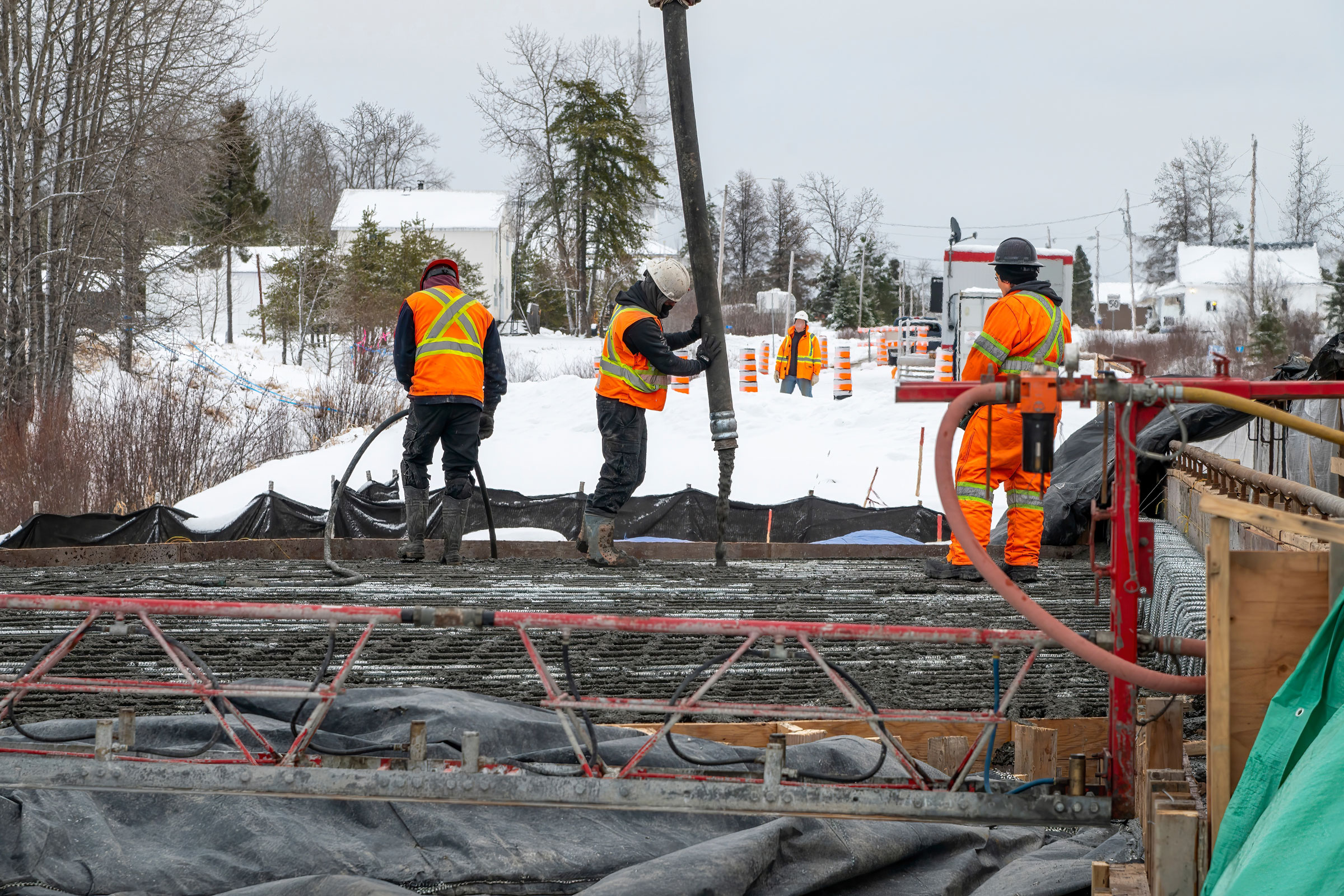Story at a glance:
- Design teams in California must meet strict building codes and regulations.
- Outdoor areas lead to biophilic design benefits in the workplace, schools, and more.
- Firms big and small search for ways to make their projects better for occupants.
California doesn’t mess around. The state takes sustainability seriously and ranked 10th among the 2019 Top 10 States for LEED, according to the USGBC. CALGreen is California’s first green building code and the first in the nation state-mandated green building code.
In talking to architects about green buildings, we often hear how California is “different,” with strict building codes and serious regulation. That may be why California also has some of the most inspiring projects out there. Here are five green buildings in California that we can’t stop talking about.
1. Paradise High School, Studio W Architects
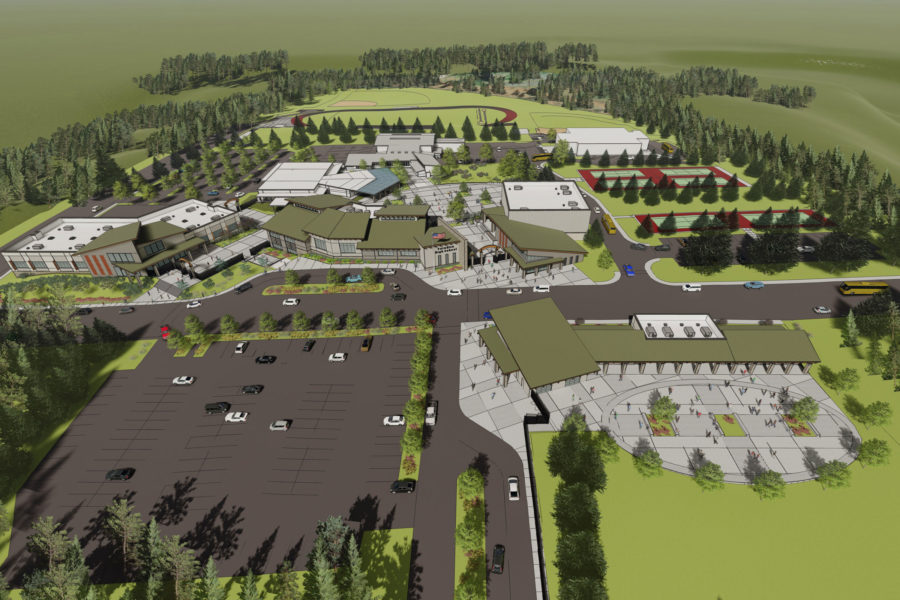
An overview of the new Paradise High School in California, designed by Studio W Architects. Rendering courtesy of Studio W Architects
After a tragic fire destroyed much of Paradise, Studio W Architects was tasked with reimagining what could be for the Paradise Unified School District.
“In the revised plan we are focusing on the high school because everybody in that community goes to one high school. We want to make that a truly globally competitive high school with technologically advanced educational environments, career tech education, STEM spaces, visual performing arts, a lot of things they didn’t have before,” said Brian P. Whitmore in a previous conversation with gb&d.
The project is currently in progress, and the high school will receive all new classroom facilities as well as a new multistory classroom facility and administration building. “The high school will be completely transformed,” Whitmore told us.
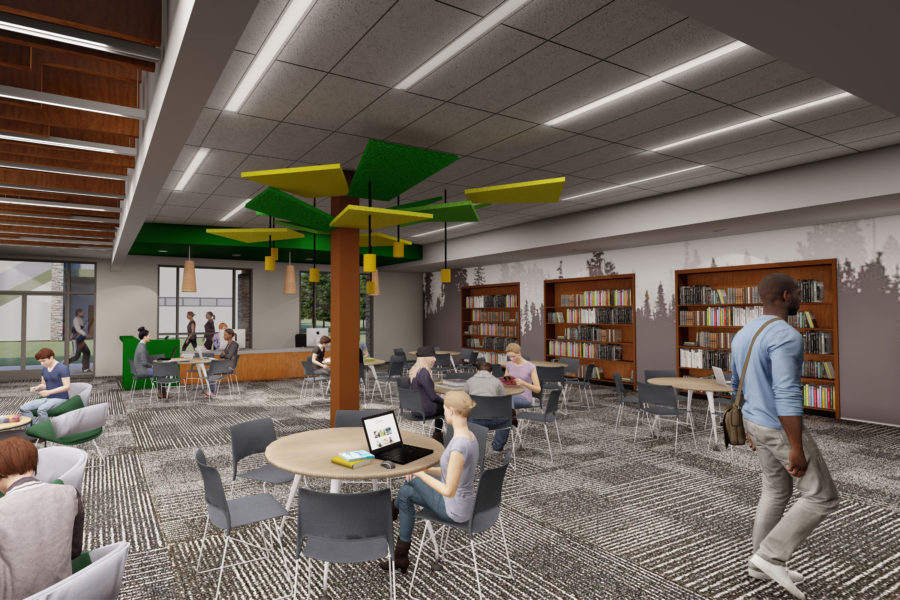
The new Paradise High School library is planned to be an open, vibrant space. Rendering courtesy of Studio W Architects
All work is expected to be complete by 2023.
This project’s features include:
- Timber environment with sloped roofs
- Fire-resistant construction
- CMU (concrete masonry unit) construction
- Metal framing
- Cementitious siding
- Plentiful natural light
- Rolling doors for fresh air
- Fire sprinklers
- Power generator
2. Fairview Heights, KFA
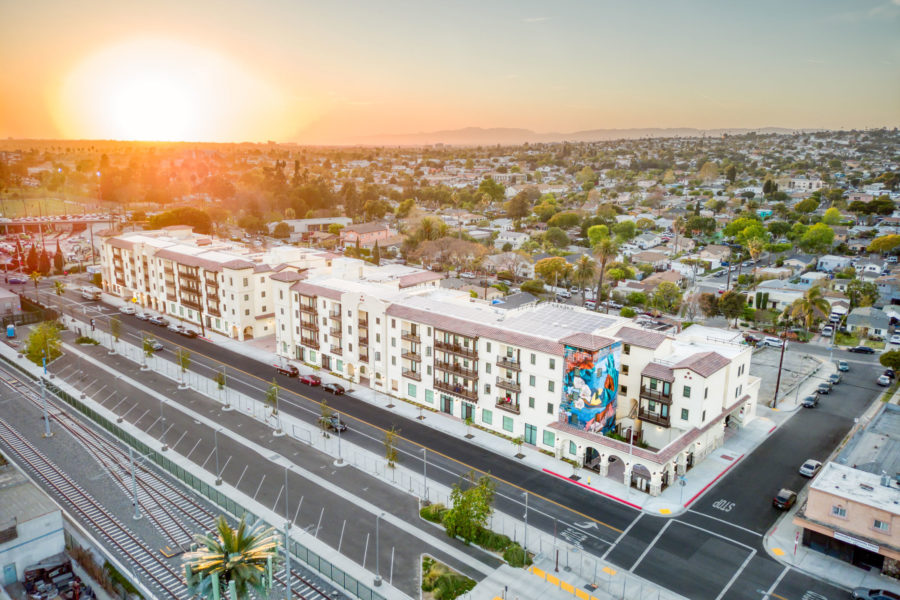
Fairview Heights in Inglewood, California, designed by KFA. Photo by ArchLenz Photography
In Inglewood, KFA designed more than 150,000 square feet of sustainable affordable housing. The LEED Gold Fairview Heights project is a beautiful example of collaboration brought to life. The final design has more than 100 units of affordable housing, ground floor retail space, a community police center, youth and adult educational space, and more.
“One of the most impressive features of Fairview Heights is the extensive solar panel array on its roof,” KFA Partner John Arnold previously wrote for gb&d. “From the early stages of design KFA anticipated the need to keep as much of the roof area as free as possible. In multifamily buildings this can be a challenge, as roof space is typically occupied by the large quantity of mechanical condensers that serve each dwelling unit. However, by prioritizing the roof space for solar, we made sure all other systems and design features would support that commitment. In lieu of standard mechanical condensers, KFA opted for wall-mounted heat pumps that could be installed on the parapet walls around the perimeter of the roof.”
The PV system was designed to generate enough onsite electricity to support the nearly 14,000 square feet of common space, which includes a large community room with a teaching kitchen, a computer lab, case management and resident service offices, and conference rooms.
The landscape design and plant selections were also made with sustainability in mind. As part of the county requirements, a minimum of 75% of the plant selections that were made are drought-tolerant. Each of the second-floor courtyards features raised planters with vegetable gardens and outdoor barbecues with an overhead trellis, and a tot-lot with play structure for children. These amenities allow the courtyards to foster a sense of community and interaction for residents of all age levels.
But this project is also special for its art. A mural called “Rise Above” by local artists Yanoe and Zoueh is a visual expression of what this project represents for its residents and the community at large. “The imagery features flowers local to Inglewood, while the joined hands are symbolic of home, unity, and security,” Arnold said.
This project’s features include:
- Transit-oriented design
- Onsite electricity generation
- Energy-efficient mechanical systems
- Water-wise landscaping
3. Stanford Center for Academic Medicine, HOK
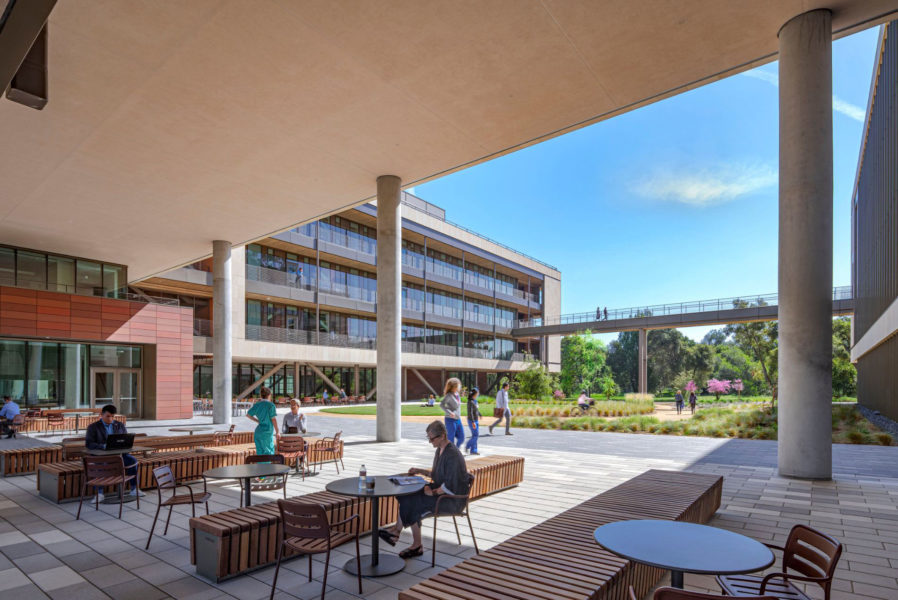
The HOK-designed Stanford Center for Academic Medicine in Northern California includes a west office wing that’s lifted above the ground to form a large porch below. The building massing serves as a threshold between the Stanford Medicine academic and clinical campus in Palo Alto and the adjacent Frederick Law Olmsted-designed arboretum. Three narrow, interconnected office wings rise above a landscaped courtyard planted with native species. Photo by Tim Griffith
The new HOK-designed Stanford Center for Academic Medicine in Northern California successfully marries form and function in a state-of-the-art space that’s welcoming, energizing, practical, and sustainable.
The design takes advantage of Northern California’s mild climate by moving 20% of the program beyond the building’s walls. People can socialize and work in a diverse mix of outdoor spaces.
“We like organic spaces; we want to feel that connection, which has repeatedly been shown to help people feel healthier and more engaged, or to enhance creativity and set a positive mood,” Kay Sargent, director of HOK’s global workplace practice, previously told gb&d. “All of those things we find in nature create much richer experiences. We really need to start thinking about how we can better incorporate them to create more thriving workspaces.”
This project’s features include:
- 20% of the built program repurposed outdoors
- Fine-tuned “microclimates” that enable comfortable outdoor environments year-round to reduce building size
- Three narrow, interconnected office wings that rise above a central landscaped courtyard, forming a U-shaped building that provides views to nature from all vantage points.
- Intentionally narrow internal wings with workspaces that are no more than 30 feet from a window for uniform natural light exposure.
- Public access through an open-air breezeway and connection to the arboretum’s trails.
- Outdoor access from the office wings via walkways overlooking the courtyard, and bridges that traverse the courtyard edges.
- Curtain wall that minimizes glare while optimizing indoor thermal comfort and daylight
4. Parkside North, Gensler

Solar panels are visible from the rooftop terrace, creating a visual connection to the project’s sustainable features. Photo courtesy of Gensler
Students are practically fighting over who gets to live in the new Parkside North dormitory at California State University, Long Beach (CSULB). The four-story, 127,000-square-foot complex includes 474 beds in various configurations, kitchen and dining areas, study pods, and outdoor gathering spaces. More than a place to live, the team at Gensler says this residence hall was designed to foster community.
The housing complex needed to meet a range of needs. “This is their home away from home,” Donna Barry, a design director at Gensler, told gb&d in a previous article. “It was very intentional that it wasn’t one size fits all. Depending on your mood, on what’s happening, on what you want to do, you have this flexibility and variety of spaces between the inside and out.”
Furniture and lighting choices were made to create different kinds of moods. The kitchen has funky, fun lights and colorful tiles to create an active space. The study rooms use more refined lighting. The lighting in the study rooms is more refined. The lighting and furniture in social spaces needed to be adaptable to changing uses throughout the school year. For example, the arrangement for a movie night would be different from a study session during finals week.
The design also arranged indoor spaces around two courtyards. This allowed 90% of student rooms to face north-south, helping optimize energy use. They also coordinated programming in the building so that regularly occupied spaces were placed in areas that don’t need as much active energy.
This project’s features include:
- Net-positive energy
- Net-zero water
- 90% of student rooms to face north-south
- Operable windows
- High-performance rainscreen
- 235 solar panels
- Pursuing LEED Platinum
- Pursuing Living Building Challenge Petal
5. Edwin M. Lee Apartments, Leddy Maytum Stacy Architects
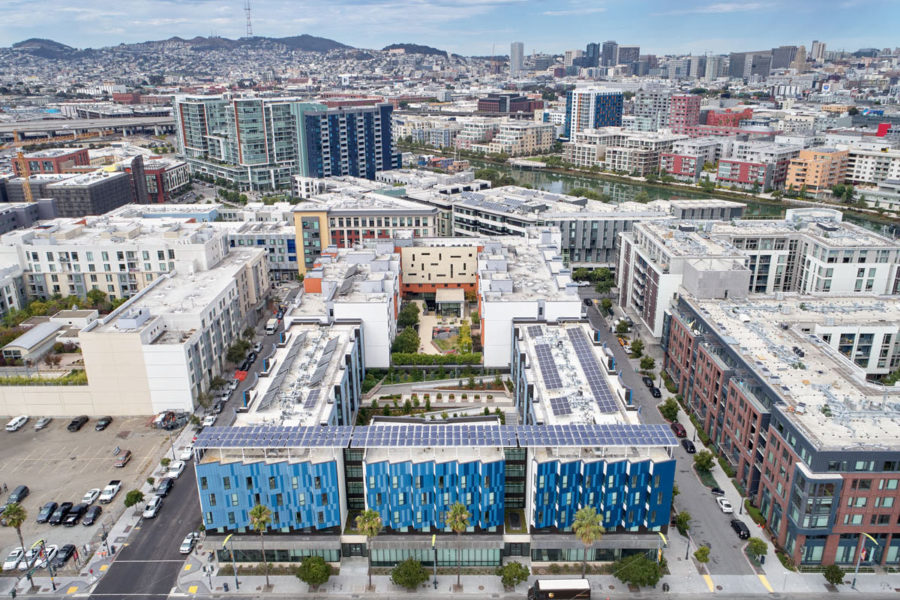
Edwin Apartments. Photo by Bruce Damonte
The Edwin M. Lee Apartments by Leddy Maytum Stacy Architects is another great example of affordable housing in California. The building provides 62 apartments for formerly homeless veterans and 47 apartments for families earning between 50% and 60% AMI.
“The team considered trauma-based design and universal design principles, as they worked to create a welcoming home for veterans and provide dedicated programmed spaces for kids and teens, incorporating both needs in the shared courtyard space,” wrote Gwen Fuertes for gb&d in a previous feature.
At the site scale, the square-shaped lot was optimized to allow for a generous interior courtyard footprint, which allowed for multi-layered passive and active programming opportunities, diversity of vegetation, and scales of gathering spaces to take place. The courtyard introduced dozens of new trees to the previously barren landscape, creating a forest-like setting with access to sunlight year-round.
This project’s features include:
- Equitable design
- Low-carbon housing
- Outdoor courtyard
- Community garden
- Flexible spaces
- Reclaimed lumber and found granite
- Natural light
- Views of the bay
- Solar panels



